PHYSICS FORCEPS: Best Approach to Atraumatic Extraction
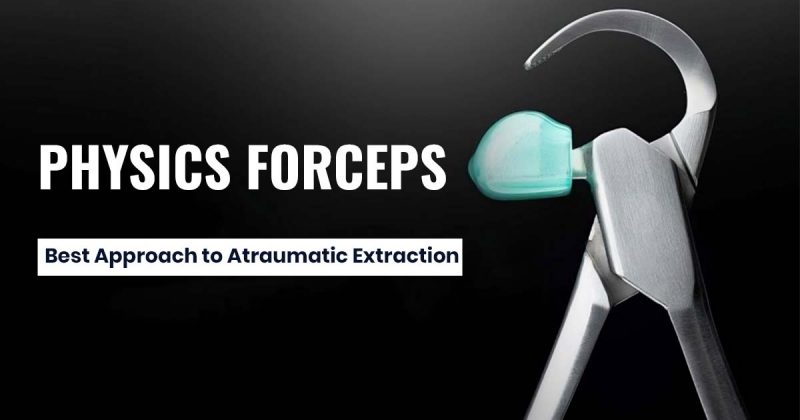
PHYSICS FORCEPS: Best Approach to Atraumatic Extraction – As a dentist, one of the primary goals during tooth extraction should be to minimize trauma to the surrounding tissues. Achieving this can often be challenging, but with proper flap elevation and the correct use of elevators or forceps, it is usually possible. Despite best efforts, there are instances where extracting a tooth in a single attempt proves difficult, leading to trauma and the need for a more surgical approach.
In 2004, Dr. Richard Golden introduced an innovative solution: Physics Forceps. These instruments are designed to simplify tooth extraction while minimizing trauma. Unlike traditional tools, Physics Forceps uses a unique approach with two key components: the beak and the bumper.
Types of physics forceps :
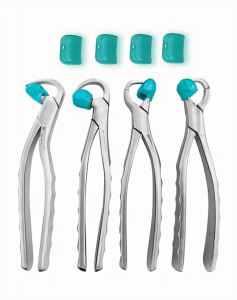
Physics Forceps are specialized for a particular tooth to be extracted and are of following types:
- Upper Right Posterior Teeth
- Upper Left Posterior Teeth
- Upper Anterior Teeth
- Lower Universal Forceps
They are also available in two series:
- Standard Series for adults
- Pedo Series for pediatric patients
Biomechanics of physics forceps:
Physics Forceps operate on the First Class Lever Principle. Here’s how they work:
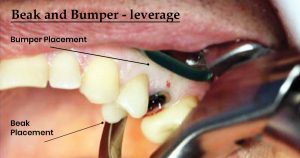
- Bumper: One handle of the forceps connects to the bumper, which acts as the fulcrum during the extraction.
- Beak: It is positioned into the gingival sulcus on the lingual or palatal root of the tooth.
- Bumper Placement: The bumper is placed on the facial aspect of the dental alveolus, near the mucogingival junction.
With these forceps, it is recommended to avoid applying squeezing pressure to either the handles or the tooth, and rotate the handles together as a single unit through a few degrees. The beak remains stationary and does not exert additional force on the tooth, preventing it from splitting, crushing, or fracturing.
Why is Atraumatic Extraction Important?
Atraumatic extraction offers several benefits:
- Preserves Bony Structure: Minimizes damage or fracture to the surrounding bone.
- Faster Healing: Reduces postoperative pain and accelerates recovery.
- Reduces Ridge Deformities: Helps maintain ridge integrity post-extraction.
- Maintains Gingival Architecture: Preserves the gum structure for better aesthetic outcomes.
- Decreases Food Entrapment: Reduces issues with food entrapment in traditional fixed partial dentures.
- Facilitates Immediate Implants: Provides a better foundation for placing immediate implants.
Additionally, atraumatic extractions help reduce the incidence of dry sockets and contribute to quicker orthodontic treatments following the extraction.
How do physics forceps have an edge over conventional forceps and elevators?
| Features | Physics Forceps | Conventional Forceps |
| Design | Employs a first-class lever system with a plastic-coated bumper for effective extraction | Traditional design with beaks that grasp, squeeze, and twist the tooth |
| Mechanical Advantage | Offers a strong mechanical advantage through steady, consistent pressure | Lacks the same mechanical advantage, leading to less efficient extraction |
| Biomechanical Benefits | Creates a more efficient extraction process with less incidence of crown and root fractures | Increased risk of crown and root fractures because of intermittent trauma |
| Trauma to Periodontal Ligament | Applies steady trauma, resulting in greater hyaluronidase release and easier tooth removal | Trauma is intermittent, resulting in less effective biochemical breakdown |
| Control and Pressure | Applies controlled pressure parallel to the root’s long axis, reducing squeezing and crushing forces | Applies compressive and twisting forces that may result in crown fractures |
| Bone Preservation | Applies compressive force to support and preserve the buccal bone, reducing fracture risk | Higher risk of buccal bone fractures due to less controlled pressure |
| Efficiency in Extraction | Requires minimal strength and maximum patience, leading to smoother extraction | May require more force and result in less controlled extraction |
| Clinical Application | Regarded as valuable for atraumatic extraction and maintaining buccal bone, which is advantageous for implant dentistry | More likely to cause damage and may be less effective in preserving bone |
What is the proper technique for employing physics forceps effectively?
Local anesthesia is to be administered with 2% mepivacaine HCL with 1:20,000 levonordefrine. Buccal and palatal infiltrations are used for the upper teeth, while inferior alveolar and lingual nerve blocks are administered for the lower teeth, supplemented with buccal infiltration for lower molars.
Steps of Dental Extraction with Physics Forceps:
- Initial preparation:
- Separate the lingual gingival attachment from the tooth using a mucoperiosteal elevator.
- Positioning the Forceps:
- Open the forceps handles widely. Place the extraction forceps with the disposable silicone bumper over the buccal tissue, deep within the vestibule, and apically to the patient’s alveolus. Ensure the bumper (covered with plastic or rubber to prevent trauma to the buccal soft tissues) is positioned perpendicular to the tooth at about the level of the mucogingival junction. This position is to be held securely without squeezing the handles.
- Set the beak into the depth of the lingual or palatal sulcus on the solid root surface, at least 1–3mm sub-gingivally. For effectively rolling the tooth out, a secure purchase point on the solid root surface is crucial.
3. Application of Force: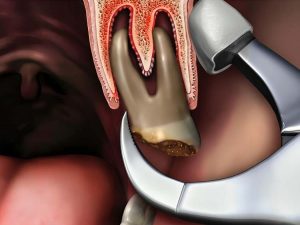
- Apply a steady and slow rotational force in the direction of the bumper, using only wrist movement. Avoid squeezing the handles or moving the arm.
- Continue the rotational force until the tooth becomes loose.
4. Final Extraction:
- The application of tension on the palatal root widens the socket around all roots, allowing the tooth to be lifted slowly and usually intact while protecting and preserving the bone walls surrounding the tooth.
Best physics forceps available online:
Some of the renowned brands for dentists to explore good quality forceps are Laros, Waldent, GDC, and Filay Dent.
Waldent being one of the leading brands, provides the best physics forceps to dental professionals. It is the unique design of their instruments that helps in the predictable and efficient removal of the tooth with only minimum strength required from the operator. Maybe it’s time for you to elevate your dental practice with Waldent’s Physics Forceps and experience the benefits of superior design and efficiency. So, enhance your procedural effectiveness and provide your patients with the best care possible.
Take home message:
Several studies have shown that the usage of atraumatic forceps or physics forceps has helped dentists to achieve atraumatic extractions thus preserving the surrounding structures. Comparative analyses between traditional extraction methods and these advanced forceps reveal that selecting the appropriate instruments can notably reduce the risk of tooth fracture or splintering during the extraction process.
It is highly recommended that dentists incorporate physics forceps into their routine practice to streamline procedures and enhance their effectiveness thus, delivering superior patient care!

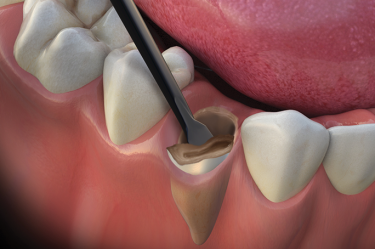
No Comment